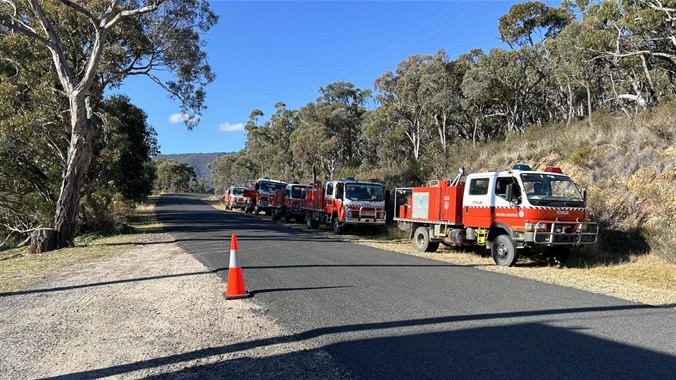Nestled 16km east of Bathurst, Hillview Estate Reserve at Napoleon Reef stands as a testament to the delicate balance between nature and human intervention. Comprising 6.3 hectares of Brittle Gum – Broad-leaved Peppermint - Red Stringybark Open Forest vegetation, the reserve faced challenges stemming from a lack of prescribed burns, which led to the encroachment of invasive species and heightened bushfire risks.
In 2017, the Napoleon Reef Landcare Group took the initiative to propose an ecological prescribed burn approach for the reserve to Bathurst Regional Council, the reserve's land manager. The objective was clear: lets enhance native ground cover, biodiversity and ecosystem integrity. While neighbouring properties underwent prescribed burns for fuel management, the reserve itself had not witnessed controlled burns, contributing to the proliferation of invasive species, particularly blackberry, and the decline of native marsupials due to the presence of European rabbits and red foxes.
The Hillview Estate Reserve Ecological Burn Program was integrated into the Bathurst Region Vegetation Management Plan (2019), aligning with the broader community goal outlined in the Bathurst 2040 Community Strategic Plan to protect and improve regional biodiversity. The specific objectives of the project included minimising potential bushfire impacts, managing fire regimes to enhance biodiversity, reducing invasive plant species, promoting native species germination, and mitigating fuel loads.
Engaging Eco Logical Australia, Bathurst Regional Council developed the Hillview Estate Reserve Ecological Burn Plan to guide the process. The plan addressed fire prescriptions, techniques, and safeguards to ensure compliance with NSW Rural Fire Service requirements while protecting local ecological and cultural values.
Implementation began by dividing the reserve into four burn units. Burn Unit 1 underwent an ecological prescribed burn in May 2021, following a flora survey and photo point monitoring in November 2020. The operational plan involved collaboration with local stakeholders, including Wiradjuri Elders to safeguard Aboriginal cultural heritage values. Skillset Landworks was contracted for preparation, and despite challenges, the ecological burn was executed successfully.
Achieving the project's objectives required a collaborative effort, with 403 volunteer hours contributed by 85 individuals from various organisations, including Bathurst Regional Council, Napoleon Reef Landcare Group, and NSW Rural Fire Service. The success of the ecological burn exemplifies effective cooperation between local government, government agencies, and the community.
Post-burn observations indicate positive outcomes, with native groundcovers responding well to the ecological burn. The anticipated mass germination of native seeds is expected to follow, providing a foundation for long-term biodiversity. While weed growth is anticipated, the Hillview Estate Reserve Ecological Burn Plan recommends a cautious approach through the use of bush regeneration techniques.
Looking ahead, the implementation of low-intensity burns at recommended intervals will create a mosaic effect, promoting biodiversity and protecting ecological and cultural values. The ecological prescribed burn has not only reduced bushfire-related impacts but also enhanced the reserve's resilience to adverse weather conditions, safeguarding homes, cultural values and conservation areas.
In essence, the Hillview Estate Reserve Ecological Burn Project stands as a shining example of community-driven environmental stewardship, where the careful use of prescribed burns has not only restored biodiversity but also strengthened the bonds between local stakeholders committed to preserving the natural beauty of this much-loved reserved.
Hillview Estate Reserve Ecological Burn
In May 2024, Council with the assistance of the NSW Rural Fire Service - Chifley Lithgow District, Napoleon Reef Landcare, Napoleon Reef Residents Association and Napoleon Reef landholders undertook an ecological burn at Hillview Estate Reserve at Napoleon Reef.
In Australia, fire is a natural event that has changed and shaped the Australian landscape over time. For many vegetation communities such as that evident at Hillview Estate Reserve – a Red Stringybark, Brittle Gum & Inland Scribbly Gum Dry Open Forest, fire is an important ecological process that shapes relationships between native plants, animals, and their environment.
This ecological burn was undertaken in accordance with the Hillview Estate Reserve Ecological Burn Plan prepared by a EcoLogical Australia and adopted by Council in 2019. The plan is based on a flora survey undertaken at the reserve by Napoleon Reef Landcare and includes guidance on techniques and safeguards to implement the burn.
A low intensity, cool burn was carried out to encourage the regrowth of native herbs, forbs and grasses, with the vegetation purposely burnt in a patchy mosaic manner so that only approximately 50% of the plot was burnt. The works will also assist in reducing the fuel build up at the reserve and the risk of an uncontrolled bushfire occurring in the hotter months.
IMAGES: Gerarda Mader - Walang Glanmire NSW RFS Brigade/Napoleon Reef Landcare


